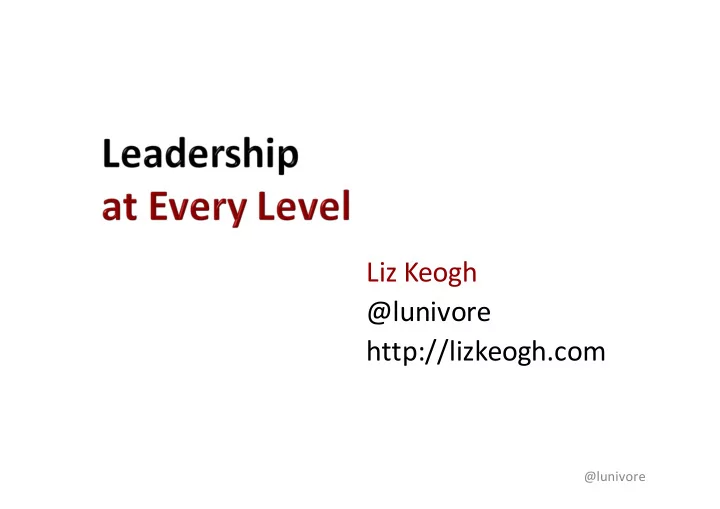

Liz Keogh @lunivore http://lizkeogh.com @lunivore
@lunivore
Forbes: Top 10 qualities that make a great leader Honesty Positive Attitude Delegate Creativity Communication Intuition Confidence Inspire Commitment Approach Roger Trapp http://www.forbes.com/sites/tanyaprive/2012/12/19/top-10-qualities- that-make-a-great-leader/ @lunivore
@lunivore
@lunivore
@lunivore
“…a fundamental assumption of organizational theory and practice: that a certain level of predictability and order exists in the world.“ - Dave Snowden, “A Leader’s Framework for Decision Making” @lunivore
Cynefin Complicated Complex analyze probe Obvious Chaotic categorize act With thanks to @lunivore David Snowden and Cognitive Edge
Cynefin Complicated Complex Leadership emergent through leadership expertise Obvious Chaotic leadership Leadership through through control action @lunivore
Estimating Complexity 5. Nobody has ever done it before 4. Someone outside the org has done it before (probably a competitor) 3. Someone in the company has done it before 2. Someone in the team has done it before 1. We all know how to do it. @lunivore
Estimating Complexity 5 4 3 2 1 @lunivore
The Innovation Cycle Spoilers Differentiators Commodities Build on
Dreyfus Modelling Novice Experienced Beginner Competent Practitioner Knowledgeable Practitioner Expert @lunivore
Dreyfus Modelling 1. Novice “You do you” 2. Beginner Seek Independence 3. Practitioner Seek Desire Impostor 4. Knowledgeable Syndrome! 5. Expert Oh, yeah! @lunivore
The “Grow” Framework G oal R eality O ptions W ay Forward @lunivore
Growing Context in which we act Given a context When an event happens Then an outcome should occur
Growing Action we take Given a context When an event happens Then an outcome should occur
Growing Given a context When an event happens Then an outcome should occur Outcomes
A really great leadership trait! “I am feeling stressed… that’s interesting.” @lunivore
The Safety Check (numbers) 1. I am going to nod and stay quiet. 2. I might talk about some things I want to fix. 3. I will share my opinions, but I’ll stay away from some controversial stuff. 4. I will talk frankly but sensitively. 5. I feel safe to say anything in front of this group.
The Safety Check (ESVW) E xplorer S hopper V acationer P risoner @lunivore
@lunivore
Julian Birkinshaw’s Organizing Models Bureaucracy Meritocracy Adhocracy Position Action Knowledge Mutual By Rules Opportunity Adjustment Logical Experiment- Hierarchy Argument ation Extrinsic Personal Achievement Rewards Mastery @lunivore
Information Arrival Information Point at which most decisions are made t @lunivore
Deliberate Discovery Assume ignorance Assume second order ignorance Optimize for discovery
Real Options Options have value Options expire Never commit early unless you know why
Where are your commitments and investments? Yearly Up-front Work done High cost budgeting Regulatory analysis but not in of making cycle work use ready for use requirements Quarterly Regulatory Lightweight Small, Great / rolling feedback planning frequent engineering, budget changes continuous deployment, culture of change @lunivore
Bain Analysis, 2007 Highly % 3-year Aligned Alignment Trap IT-Enabled Growth growth +35 % IT +13 Spending 7% 11% -14 -6 Maintenance Zone Well-Oiled IT +11 0 74% 8% -15 -2 Less Aligned Less Highly Effective Effective
Cynefin Breaking Trying things down things out
A Safe-To-Fail Probe has… A way of knowing it’s succeeding A way of knowing it’s failing A way of dampening it A way of amplifying it Coherence
Coherence A realistic reason for thinking the probe might have a positive impact Can you give me an example? @lunivore
Examples Given a context When an event happens Then an outcome should occur
Well-formed outcomes Vision Hearing Smell Taste Sensation Kinesthetic Propriaception @lunivore
In high uncertainty… …scenarios provide coherence, not tests @lunivore
Multiple success scenarios Ensures you’re not hung up on one outcome Makes it more likely that you’ll consider failure @lunivore
Coherence Given Kate doesn’t know much about the PO role When she reads my guide Then she should understand it better. @lunivore
“That won’t work because…”
Failure Scenarios Given Kate doesn’t know much about the PO role When she reads my guide Then she might feel helplessly lost. @lunivore
A Safe-To-Fail Probe has… A way of knowing it’s succeeding A way of knowing it’s failing A way of dampening it A way of amplifying it Coherence A way of avoiding failure completely @lunivore
Changing the Context Given Kate doesn’t know much about the PO role And she knows everything is new and we’re trying things out When she reads my guide Then she should let us know that didn’t work for her. @lunivore
Fail-Safe Then it should also work in production @lunivore
Safe-To-Fail Then we should be able to roll it back @lunivore
The Palchinsky Principles Seek out new ideas and try new things When trying something new, do it on a scale where failure is survivable Seek out feedback and learn from your mistakes as you go along @lunivore
Yes, and… @lunivore
Liz Keogh Freelance Consultant http://lizkeogh.com @lunivore
New behaviour Write a failing test
Refactor and anchor what you value! Existing behaviour
Number 1 rule of feedback: Anchor what you value!
New behaviour Write a failing test Refactor and anchor what you value! Existing behaviour
New behaviour Describe Write a desired failing test behaviour Refactor Change Make it the and anchor pass what you value! behaviour Existing behaviour
The sandwich model Start with something good Say something bad Finish with something good
The sandwich model done right Anchor what you value Describe desired behaviour THEN change the behaviour (People can do this bit themselves!)
Liz Keogh Freelance Consultant http://lizkeogh.com @lunivore
Recommend
More recommend